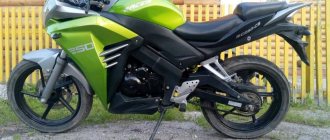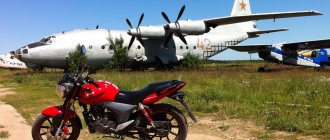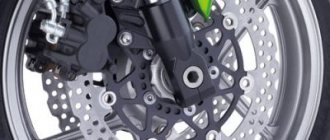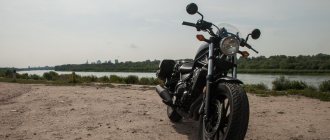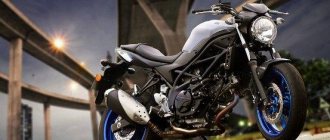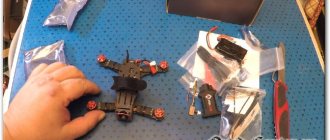Anyone who has ever seen the once famous Tula motorcycle, notable for its non-standard design, will immediately find the Racer Forester familiar. Despite the fact that it is designed to overcome off-road conditions, it has little in common with the enduro class. The Forester 200 racer is a utilitarian bike that combines riding capabilities both on public roads and beyond. A rough silhouette, as if carved with an axe, defiantly thick wheel donuts, the absence of any visual frills... That's right, before us is the Racer Forester RC200LT, a real hard worker from China, unpretentious and hardy.
Racer Forester Specifications
What should a motorcycle for rural areas ? As simple, reliable and durable as possible. This concept formed the basis of the Forester Racer 200, although the execution raises some questions. So, the bike frame is made of thick and durable steel elements , but they are welded together somehow. The plastic is neither thick nor flexible, but it is obvious that the motorcycle will sometimes fall off-road. However, there are still more positive aspects. When you sit on the Racer Forester 200, you immediately feel like you’ve been riding it all your life; it’s really comfortable and well thought out in terms of ergonomics.
The engine evokes only the most positive emotions. Of course, this is just a small-capacity car, but the 4-valve 15-horsepower engine behaves very well. There is traction at the bottom, and it feels like it “deflates” only at the top. In the upper rev range there is a lot of unpleasant vibration, but, alas, this is typical for single-cylinder engines. But the Chinese designers thought that the Forester Racer 200 would be operated in harsh conditions, and therefore they equipped the engine with two oil coolers. The gearbox has 5 speeds and works properly. The motorcycle is capable of reaching speeds of 100-105 km/h .
The suspensions on the Forester Racer 200 are simple, but energy-intensive, and you will have to try to “break through” them on uneven surfaces. Of the settings, however, there is only pretension adjustment on the rear monoshock absorber, but oh well, that’s not a problem. Even under a heavy motorcyclist, the bike does not sag, and a pothole that suddenly appears right ahead is unlikely to become a problem for you. Moreover, it is difficult to call the brakes effective, while the front disc brakes even more or less cope with their job, while the rear drum brakes seem to have only two positions - “on” and “off”. By the way, when driving over rough terrain, the appetite of the Racer Forester engine increases sharply from 2.5-3 liters to 4-4.5 or more, depending on the quality of the fuel and specific operating conditions. However, 12-liter gas tank is still enough, and the Japanese carburetor is not too picky about the quality of gasoline.
What is important is that the bike weighs a little, only 145 kg . Considering that it is intended mainly for off-road driving , this is very important. But it is not difficult to hold it, and the low center of mass greatly contributes to this. But in open spaces, the Racer Forester is easily blown away by strong side winds, which is worth keeping in mind when going out onto the highways.
I had a cleha (Kawasaki KLE400) from a dense '97 model. Here's one, only repainted dark blue and with battered plastic:
Everything basically suited me except for three things. 1) It’s hard for me with it in city traffic jams due to the high central temperature and the deficiency of my physiology. According to the specifications, its dry weight is 175. Let's add 15-20 kilograms of liquids. Let's add a very high CG and, according to my feelings, the total result is a cast-iron fence, which, while standing still, should in no case be noticeably tilted, otherwise, while sitting in the saddle, you will not be able to keep it from falling on its side. 2) As befits a 20-year-old motorcycle that has been used for its intended purpose - it is quite tired and sometimes asks for replacement of worn-out parts that are rarely available anywhere. You have to order and wait, looking longingly at the motorcyclists from the car. Actually, it was this waiting that was annoying. 3) Contains a certain amount of snot and collective farm, created by previous owners and sometimes giving out unpleasant surprises.
I somehow came to terms with the second and third points. But the first point constantly urged me to change the bike for something not so heavy.
First, I decided to exchange the clekha for some relatively fresh Japanese meat. I analyzed the proposals and chose the Suzuki Djebel 250 XC no older than 2005.
But after a sober assessment of my financial capabilities, I stated with great regret that I couldn’t cope without a loan. Since for some time now I had sworn off taking loans, and my wife had vetoed the theft of family savings, the budget was quite defined - the proceeds from the sale of “klekha”. It amounted to 118 thousand.
What can you buy with 118,000 rubles at the end of summer 2016? The first option is the same ancient device as the sold klekha. For example TTR250 Raid.
But not like in the picture, but shaky and well-groomed. As it stands, I didn't like this option at all. That's not why I sold the klekha. The second option is obviously Chinese. Looking at the mostly satisfied Sinologists, I tucked my pride a little and began a new search.
So, all efforts were devoted to analyzing the Chinese. Based on the existing knowledge about Chinese spendthrifts and tons of more detailed material studied, I made several conclusions. 1) When buying a Chinese product, you need to be prepared to tinker with it in order to correct mistakes and improve it in an amount directly proportional to the degree of personal maximalism and sense of beauty. 2) New Chinese is extremely illiquid, so it makes sense to buy new only for the purpose of taking it for a long time. This implies a patient and thorough approach to selection. 3) If you take a Chinese car new, then at the slightest opportunity you should take it “in a box” and assemble it yourself, using the advice and instructions of those who have already gone through this. This is due to the fact that in Chinese stores they usually collect and make a “pre-sale” for weaning... ahem... extremely poorly in general, putting pigs in the form of mutilated oil seals, overtightened bolts, licked threads, etc. 4) If you take a used Chinese one, then either one about which everything is known for certain, or for a very inexpensive price, 50% of the price of a new one, for example. Because for the most part, the Chinese go through the above-described shit assembly and ride around like careless riders without replacing the factory shit with decent fluids and even without a proper break-in. They are limited to “tightening” what can be reached without removing the tank. Because most people are too lazy to poke around and look for information - “the tea won’t fall apart right away, and then I’ll sell it.” As a result, the moto can be seriously damaged despite its still fresh appearance.
I also decided on the model. I decided that the Motoland Enduro 250 and Irbis TTR250R suited my needs and budget.
Motoland is 20 thousand cheaper, but there are much fewer reviews and information on it and there is only one color - red. Even the seat is red, which completely went against my preferences. Irbis offers as many as 3 colors: red, blue and green, which pleases my eye. In the end, I gave preference to the snow leopard in green, and left Motoland as a spare. However, there is one important point: from the 2016 model year (i.e., production starting somewhere in the second half of 2015), the Irbis TTR250R has an engine without a balancer. In no other way did they save money so as not to raise the price. Moreover, this change is not officially reflected anywhere. According to users, vibrations at high speeds have become very noticeable, and nothing is visible in the mirrors.
I went to the dealer, made a deposit and ordered a green Irbis TTR250R box. We specifically agreed that I needed the old version, with a balancer in the engine. A week and a half of waiting and they call me - the spendthrift has arrived. All joyful, worried in my soul, I almost skipped and flew to the dealer. We open the package with it, and there is disappointment - the engine does not have a balancer. They stood there, spat, and scolded Irbisov’s managers for their stupidity. Figuring out in my mind how much it would cost to reupholster a saddle from red to black, I offered the dealer a backup option - “then bring me a Motoland Enduro 250.” We decided that I would think about it while the question of returning the snow leopard hung, and he would see when and how much he could bring the requested “backup option.”
In general, I wasn’t even going to think, I was just waiting for a call from the dealer to find out how much and when. While waiting, I continued to scour the Internet for interesting models. While still searching, I saw models with a four-valve dropsy ZS177MM, which received very good reviews.
The power of the engine is already competitive with the units found in Japanese light enduros. In general, I have my eye on this miracle. However, all the motos that I have seen with this engine are outright dirtbags. I don't need it. In addition, due to the fault of the rat, the price tags for new items have risen to unaffordable levels.
I was sitting at work in a cozy office and drinking coffee, flipping through images in a Google search for something I don’t remember about this engine, and suddenly bam, I saw an analogue of the Irbis XR250R (a clone of the Honda XRE300).
But in what I saw the desired engine was sticking out. Wow, I think, what is this? And this turns out to be Racer Crossrunner. Damn... Racer? I had previously avoided equipment under this brand because of the gypsy name and some negative general information. I didn't think they were doing anything interesting. At the same time, I all liked the Irbis XR250R and its twins, but their very archaic engine with a lower camshaft coupled with a fairly large weight was not suitable. And here everything is as I wanted: a crossover with a decent ground clearance, a very peppy dropsy, 135 kg of dry weight, and at the same time, much of what is usually added to other Chinese here already in stock: a 520 chain, an aluminum steering wheel with spacers, aluminum wheel rims, hand protection on aluminum frames (not plastic), reinforced brake hoses, etc. Looking ahead, I’ll say that his CG is also quite low - as a result, I can put it on its side and lift it with fairly moderate efforts, without near-limit stresses, as was the case with the cleha.
In general, I was stuck. It’s stuck in my head that of the Chinese Racer Crossrunner is the closest to what I want. At the same time, I could no longer put up with the 16 horses of the previous options, because... I dug up the price tag of the crossrunner - 124 thousand new. Truth in Barnaul. Taking into account delivery to NN, this is at least 130 thousand.
Hmm, I don’t fit in a bit, I thought, and went to look at used options. In the vastness of Avito, there were as many as 3 more or less credible offers. You don't have much choice. Two of them had price tags in the region of 110k and mileage of 2k and 4k - not suitable. The third one had more than 1000 miles and a more than acceptable price tag - 70 rubles. I talked to the seller. I was convinced of the reality of the offer and strengthened my desire to at least look at this spendthrift.
Immediately I sat down to draw up a plan for the operation to buy a spendthrift. I’m in Nizhny Novgorod, and the spendthrift is in Mtsensk - Yandex maps show a route with a distance of 700 km and a duration of 10 hours. Not close in general.
The initial idea of going back on our own, to put it mildly, did not find approval from my wife. And, as it turned out, it’s practically impossible to issue a mandatory certificate on the spot, but I’m right, I won’t go without a mandatory certificate. The second idea of driving a close relative's truck was rejected by that relative as financially unsuccessful and for reasons of comfort on a long trip in a compact city van. In general, the only option left is to use the services of a shopping center. TC “Business Lines” was chosen as it, because Friends have a positive experience of using their services for transporting motors. Mtsensk is a small city and there is no “business lines” terminal there. The nearest terminal is in Orel. Moreover, on Saturday it closes early, and on Sunday it does not work at all. Taking into account all these circumstances, a final plan was quickly drawn up, which included the implementation of the following preparatory operations: - obtaining informal time off on Friday in exchange for an obligation to work on the weekend; — freight of a gazelle for transportation of a moto from Mtsensk to the TK terminal in Orel; - purchase of tickets for the locomotive NN - Moscow - Mtsensk (Thursday night) and back Orel - Moscow - NN (Friday night). The plan was to fall out of the train on Friday morning in Mtsensk, look and touch the bike, finalize the deal, drain the gas, load the bike into a gazelle, unload at the TK terminal in Orel, arrange the departure and, if there is time, modestly mark the purchase before the train departs. The plan was successfully implemented in full. A backup plan was also developed, implying a spontaneous purchase of a moto in a showroom in Moscow if there was a bummer in Mtsensk. But this plan was of no use.
In total, together with tickets, delivery and invoices, the spendthrift cost just under 88 rubles. As a bonus, I got a plastic trunk case.
The overall condition of the bike is not bad, it is fully operational. A little shabby. There are jambs, both congenital and acquired. But about them and about my struggle with them in other episodes.
I set aside part of the remaining funds for consumables and finishing touches.
I spent the rest: I wanted boots for a long time, I rode in ankle boots. And the helmet - I just wanted to change the road integral to something more universal. In general, everything is going well so far. It’s a pity that the season is almost over, and I still haven’t skated. The motor requires maintenance with passion, and there is little time for this. But today almost everything that is necessary has been done. Yesterday I finally finished repairing the rear suspension - it was delayed due to the brakes and making the pendulum bushings. There’s just a little bit left to do: seal the loose filter box pipe, replace the antifreeze and inspect the front wheel hub. I'm already waiting for the weather. Autumn is somehow too autumnal these days. It rains and chills endlessly.
Pros and cons of Racer Forester
Advantages
- Low price . This also applies to the cost of maintaining the Racer Forester 200.
- Oil filter . The design provides a full-fledged replaceable filter instead of the usual mesh, as on many other Chinese bikes.
- Off-road abilities . In skillful hands, a motorcycle can overcome even quite serious off-road conditions.
- Not bad standard tires . There is no desire to change it immediately after buying the bike.
- Winter operation . The Forester Racer can handle it too, and it drives in the snow no less confidently than in the mud.
- Comfortable seat . Wide and moderate soft.
Flaws
- Non-standard tire size . Because of this, choosing tires is not so easy. Some owners of the Racer Forester 200 put on the front wheel a tire originally intended for the rear wheel of some enduro, and on the rear wheel a tire of a suitable size for an ATV. In general, there are possible options here.
- Poor build quality . What immediately catches your eye are crooked welds, gaps between body kit elements and other little things that spoil the impression.
- Fragile plastic . It most likely will not survive a fall, and will either have to be soldered or replaced with a new one.
- Weak paintwork . The paint on the plastic may begin to peel off after just a season. In addition, it is easy to scratch.
Owner reviews
The moped growls and goes anywhere, in any conditions. It will feel a little more lively than an ebrik, but not by much. On asphalt, due to the low-pressure wheels, it starts to roll at about 70 km/h, so you have to be careful. It pulls well from the bottom, which is generally strange for a small-capacity single-barreled gun, but still good. The main disadvantage is that the front wing breaks completely at the first fall. I broke it, bought another, universal one, for 10 bucks on Aliexpress, installed it and forgot it. The turn signals are also garbage, you can unscrew them with your fingers. Otherwise ok. Anton, Leningrad region, Racer Forester '2018.
A real all-terrain vehicle that drives through snow, mud, and sand. When driving for a long time off-road, the engine gets very hot, you need to keep an eye on it. The suspensions are super, you can completely forget about the roads and just choose any direction)) Grigory, Sergiev Posad, Racer Forester 200 '2016.
It feels like the Chinese tried to copy some bike like the Suzuki VanWan, but never decided on the details. As a result, the idea was good, but the execution was disappointing, assembly was done on the knee and, obviously, by eye. Everything seems to be fine, but little things were screwed up almost everywhere, from the reserve switch tap hidden in the bowels of the bike to the voltmeter instead of the fuel gauge, which, by the way, is on exactly the same instrument panel, but on other Chinese models it is present in its rightful place. Alexey, Smolensk, Racer Forester '2019.
Video Review
Specifications
| Maximum engine power: | 15.4 hp at 8000 rpm (11.0325 kW) HP |
| Working volume: | 200 cm3 |
| Motor type (cylinder arrangement, number of strokes): | Vertical, with balancing shaft |
| Number of cylinders: | 1 |
| Number of valves: | |
| Intake type (Injector / Carburetor): | |
| Bore and stroke: | |
| Starting system (Electric starter, kick starter): | |
| Maximum speed in km/h: | 105 km/h |
| Cooling system: | Air-oil |
| Transmission (gearbox): | Mechanical, 5-speed |
| Clutch (Dry / Wet): | |
| Drive unit: | Chain |
| Frame: | Steel |
| Chassis | |
| Suspension (front/rear travel): | |
| Brakes (Front/Rear): | |
| Wheels / Tires / Rubber: | |
| Dimensions and weight | |
| Dimensions (Length / Width): | |
| Seat height: | |
| Ground clearance: | |
| Curb weight: | |
| Wheelbase: | 1340 mm |
| Weight: | 145 kg |
| Fuel tank capacity: | 14 l. |
| Battery capacity: | |
| Year of release: | |
| Country of Origin: |
Criterias of choice
If you are planning to buy a Racer pit bike in Moscow, first of all we recommend paying attention to the engine power:
- 50–110 cc cm. Such models are more suitable for measured and calm walks and children’s rides. The maximum speed is usually no more than 60 km/h.
- 125–140 “cubes”. The best option for a beginner motocrosser or teenager. The load on the vehicle should not exceed 130 kg; The maximum speed, as a rule, is no more than 90 km/h.
- 160–190 cc cm. This is a great choice for more experienced motocrossers. Allows you to develop high speed on rough terrain.
- 200–250 cc see. Pit bikes with such engines perform excellently off-road.
Our store managers are ready to provide professional assistance in choosing a vehicle. We will help you choose the best option, taking into account the client’s requirements and the operating characteristics of the equipment. By cooperating with us, you get a high-quality pit bike at an affordable price with the possibility of service. We guarantee an individual approach to each customer and offer a large range of original consumables and components.
